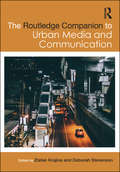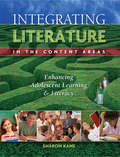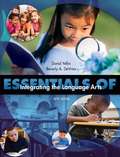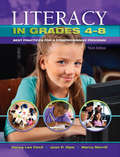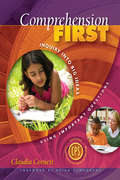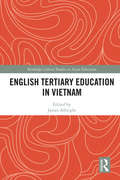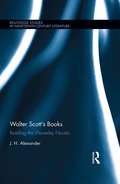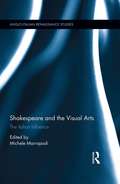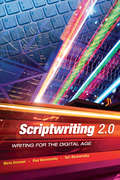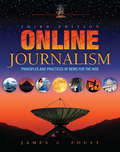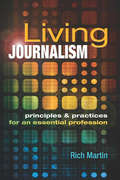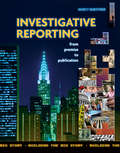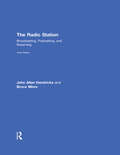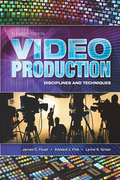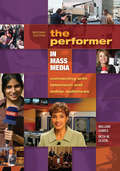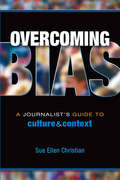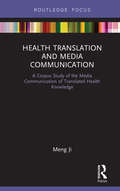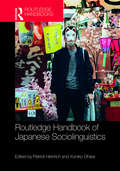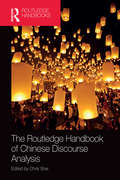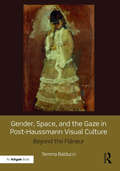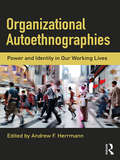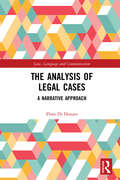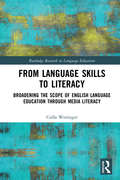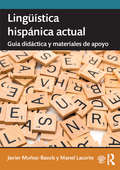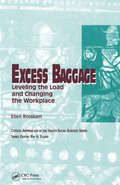- Table View
- List View
The Routledge Companion to Urban Media and Communication
by Deborah Stevenson Zlatan KrajinaThe Routledge Companion to Urban Media and Communication traces central debates within the burgeoning interdisciplinary research on mediated cities and urban communication. The volume brings together diverse perspectives and global case studies to map key areas of research within media, cultural and urban studies, where a joint focus on communications and cities has made important innovations in how we understand urban space, technology, identity and community. Exploring the rise and growing complexity of urban media and communication as the next key theme for both urban and media studies, the book gathers and reviews fast-developing knowledge on specific emergent phenomena such as: reading the city as symbol and text; understanding urban infrastructures as media (and vice-versa); the rise of global cities; urban and suburban media cultures: newspapers, cinema, radio, television and the mobile phone; changing spaces and practices of urban consumption; the mediation of the neighbourhood, community and diaspora; the centrality of culture to urban regeneration; communicative responses to urban crises such as racism, poverty and pollution; the role of street art in the negotiation of ‘the right to the city’; city competition and urban branding; outdoor advertising; moving image architecture; ‘smart’/cyber urbanism; the emergence of Media City production spaces and clusters. Charting key debates and neglected connections between cities and media, this book challenges what we know about contemporary urban living and introduces innovative frameworks for understanding cities, media and their futures. As such, it will be an essential resource for students and scholars of media and communication studies, urban communication, urban sociology, urban planning and design, architecture, visual cultures, urban geography, art history, politics, cultural studies, anthropology and cultural policy studies, as well as those working with governmental agencies, cultural foundations and institutes, and policy think tanks.
Integrating Literature in the Content Areas: Enhancing Adolescent Learning and Literacy
by Sharon KaneThis practical, accessible resource will help future and practicing teachers integrate literature into their middle school or high school classrooms, while also addressing content area standards and improving the literacy skills of their students. Two introductory chapters are followed by five chapters that each cover a different genre: Chapter 3, Informational Books; Chapter 4, Fiction; Chapter 5, Biography, Autobiography, and Memoir; Chapter 6, Poetry; and Chapter 7, How-to and Hands-on Books. Each genre chapter consists of four parts: Part 1: Discusses the genre and how content area teachers can use books within that genre to further content learning and enhance literacy skills. Part 2: Offers hands-on instructional strategies and activities using literature, with activities for use in a variety of disciplines. Part 3: Presents individual author studies (three or four per chapter) with bibliographies and guidelines for using the authors' books in content area courses. Part 4: Features an annotated bibliography of specially selected children and young adult literature for that genre, organized by content area. The annotations provide information about the book, which can be used to prepare booktalks, and teaching ideas for using in a specific content area. Altogether these sections contain more than 600 annotated entries tabbed by subject area, including art, English/language arts, languages and culture, math and technology, music, PE/health, science, and social studies/history.
Essentials of Integrating the Language Arts
by David YellinEssentials of Integrating the Language Arts, Fifth Edition, offers students all the practical tools they need to be effective language arts teachers, supported by the necessary theoretical foundation. Like its predecessors, this edition presents a comprehensive approach to teaching the language arts, balancing direct instruction in the communication arts and integrating the language arts with other content areas such as music, art, mathematics, social studies, and science. It explores the important topics of community and caregiver involvement in education and offers thoughtful coverage of diversity in the schools. Practical teaching ideas are found in every chapter.The 5th Edition reflects current teaching practices, field knowledge, and research. Significant changes include: A more streamlined approach to allow readers to move quickly from learning chapter concepts and related theory and research to understanding how they are applied in classroom practices, activities, and strategies Discussion of standards, including the Common Core State Standards (CCSS), with the goal of showing readers how they can apply standards in the classroom to help meet their students' needs New teaching activities that support the chapter topics and align with the CCSS An appendix with more than 25 classroom assessment tools Discussion of current, quality children's and young adult literature, including informational texts, supported by an appendix of annotated lists of books by genre Key Features "In the Classroom" vignettes, describing real teachers implementing language arts strategies and activities with their students "RRP" (Read Research Practice) boxed features, offering ideas for activities and projects "Teaching Activities," which future teachers can use in their own classrooms "Field and Practicum Activities," which readers can use now in field and practicum settings Discussions of technology and websites, to help readers prepare to integrate technology in their own classrooms
Literacy in Grades 4-8: Best Practices for a Comprehensive Program
by Gipe P. Joan Merrill E. Marcy Nancy L. CecilComprehensive yet succinct and readable, Literacy in Grades 4-8, Third Edition offers a wealth of practical ideas to help preservice and practicing teachers create a balanced and comprehensive literacy program while exploring the core topics and issues of literacy in grades 4 through 8. It addresses teaching to standards; differentiating instruction for readers and writers; motivating students; using assessment to inform instruction; integrating technology into the classroom; working with English learners and struggling readers; and connecting with caregivers. Selected classroom strategies, procedures, and activities represent the most effective practices according to research and the many outstanding classroom teachers who were observed and interviewed for the book. The Third Edition includes added material connecting the Common Core State Standards to the instruction and assessment of literacy skills; a combined word study and vocabulary chapter to help readers integrate these important topics in their teaching; more on technology, including comprehension of multimodal texts, enhancing writing instruction with technology tools, and teaching activities with an added technology component; added discussion of teacher techniques during text discussions, strategic moves that help students become more strategic readers.Key features: In the Classroom vignettes; more than 50 activities,some with a technology component; questions for journal writing and for projects and field-based activities; troubleshooting sections offering alternative suggestions and activities for those middle-grade students who may find a particular literacy focus challenging.
Comprehension First: Inquiry into Big Ideas Using Important Questions
by Claudia E CornettThis book is about designing instruction that makes comprehension the priority in reading and in content area study. The comprehension model described responds to calls from literacy experts and professional organizations for inquiry-based instruction that prepares readers to be active meaning makers who are adept at both critical and creative thinking. Comprehension First introduces a before, during, after Comprehension Problem Solving (CPS) process that helps readers ask key questions so they arrive at a substantial comprehension product-"big ideas" based on themes and conclusions drawn from literary works and expository texts. The book further describes how to orchestrate research-based best practices to build lessons and units around big ideas and important questions. In this age of multiple literacies, all of us must learn to be more nimble users of Literacy 2.0 communication tools. Mastering problem solving is at the core of this challenge. Comprehension First embraces this challenge by inviting present and future teachers to examine WHY and HOW these tools can be used more purposefully to achieve the pre-eminent literacy goal of deep comprehension.
English Tertiary Education in Vietnam (Routledge Critical Studies in Asian Education)
by James AlbrightAs part of a long series of Vietnam’s policy objectives, English education has been identified as key to improving the quality of its rapidly expanding tertiary institutions and is crucial to the larger aim of modernising and internationalising its economy. Bringing together a wide range of Vietnamese and foreign English education scholars, and tertiary educational practitioners, this book documents the significant progress and challenges in the realisation of Vietnam’s English language policies as they are enacted in the higher education sector. Changes to Vietnam’s higher education system remain unstable, unsystematic, and insubstantial. This book provides insights into how recent Vietnamese government policy is providing for a substantial and comprehensive renewal of Vietnam’s tertiary education as part of their 2020 plan. Academics and students of English education, language policy, and nation building within the context of increased globalisation and marketisation in developing nations and Vietnam, in particular, should find this book valuable.
Walter Scott's Books: Reading the Waverley Novels (Routledge Studies in Nineteenth Century Literature)
by J.H. AlexanderScott's Books is an approachable introduction to the Waverley Novels. Drawing on substantial research in Scott's intertextual sources, it offers a fresh approach to the existing readings where the thematic and theoretical are the norm. Avoiding jargon, and moving briskly, it tackles the vexed question of Scott's 'circumbendibus' style head on, suggesting that it is actually one of the most exciting aspects of his fiction: indeed, what Ian Duncan has called the 'elaborately literary narrative', at first sight a barrier, is in a sense what the novels are primarily 'about'. The book aims to show how inventive, witty, and entertaining Scott's richly allusive style is; how he keeps his varied readership on board with his own inexhaustible variety; and how he allows proponents of a wide range of positions to have their say, using a detached, ironic, but never cynical narrative voice to undermine the more rigid and inhumane rhetoric. The Introduction outlines this approach and sets the book in the context of earlier and current Scott criticism. It also deals with some practical issues, including forms of reference and the distinctive use of the term 'Authorial'. The four chapters are designed to zoom in progressively from the general to the particular. 'Resources' explores the printed material available to Scott in his library and gives an overview of the way he uses it in his fiction. 'Style' confronts objections to the 'circumbendibus' Scott and shows how his Ciceronian style with its penchant for polysyllables enables him to embrace a wide range of rhetoric relayed in a detached but not cynical Authorial voice. 'Strategies' explores how he keeps his very wide audience on board by a complex bonding between characters, readers, and Author, and stresses the extraordinary variety of exuberant inventiveness with which he handles intertextual allusions. 'Mottoes' examines the most remarkable of Scott's intertextual devices, the chapter epigraphs, bringing into play the approaches developed in the previous chapters. The brief concluding 'Envoi' moves out again to the widest possible perspective, suggesting how readers should now be able to move on to, or return to, the novels and the critical conversation, with an appreciation of the central importance of the ludic for an appreciation of Scott in a world once again threatened by inhumane and humorless rigidities.
Shakespeare and the Visual Arts: The Italian Influence (Anglo-Italian Renaissance Studies)
by Michele MarrapodiCritical investigation into the rubric of 'Shakespeare and the visual arts' has generally focused on the influence exerted by the works of Shakespeare on a number of artists, painters, and sculptors in the course of the centuries. Drawing on the poetics of intertextuality and profiting from the more recent concepts of cultural mobility and permeability between cultures in the early modern period, this volume’s tripartite structure considers instead the relationship between Renaissance material arts, theatre, and emblems as an integrated and intermedial genre, explores the use and function of Italian visual culture in Shakespeare’s oeuvre, and questions the appropriation of the arts in the production of the drama of Shakespeare and his contemporaries. By studying the intermediality between theatre and the visual arts, the volume extols drama as a hybrid genre, combining the figurative power of imagery with the plasticity of the acting process, and explains the tri-dimensional quality of the dramatic discourse in the verbal-visual interaction, the stagecraft of the performance, and the natural legacy of the iconographical topoi of painting’s cognitive structures. This methodolical approach opens up a new perspective in the intermedial construction of Shakespearean and early modern drama, extending the concept of theatrical intertextuality to the field of pictorial arts and their social-cultural resonance. An afterword written by an expert in the field, a rich bibliography of primary and secondary literature, and a detailed Index round off the volume.
Scriptwriting 2.0: Writing for the Digital Age
by Marie DrennanOnline media is and will continue to be at the forefront of entertainment; this book introduces readers to this new world and helps them create good content for it. It is a compact, practical guide for those who want to explore scriptwriting for the digital age while also learning essential skills and techniques central to new media writing. Scriptwriting 2.0 contains advice on writing both short- and long-form webisodes as part of a series, as well as standalone pieces. It then goes beyond the writing process to discuss revising, production, promotion and copyright. It is written in a friendly, readable and jargon-free style and includes real-world examples from successful series and a sample script. Readers can access full episodes of the two series discussed at length as well as samples from several other web series.
Online Journalism: Principles and Practices of News for the Web
by Jim FoustThe third edition of Online Journalism builds on the foundations of journalism to clearly show how they can be integrated into online environments. It takes the perspective that web content shouldn't be a separate component or an afterthought but instead is a vital part of story creation. From doing research to creating the web space, to posting and getting stories into the hands of users, this useful resource gives students the tools they need. Online Journalism readies readers for wherever their news careers take them, whether it's to the online portion of legacy news organizations, to online-only startups, or to blogs, news apps and beyond. Key features include a companion website, practical activities at the end of each chapter, screenshots illustrating key concepts and a Glossary.
Living Journalism: Principles & Practices for an Essential Profession
by Rich MartinFor journalism to survive and flourish, it needs journalists who understand its importance to society, believe in and are committed to its core values, and can put those values into action. This goal is at the heart of Living Journalism, a highly readable, practical book where readers will learn the core values and principles needed to produce work that informs and enlightens an increasingly mobile and participatory audience. The advice and stories of professionals throughout the book allow veteran reporters to serve as mentors to today's journalists.
Investigative Reporting from Premise to Publication
by Marcy BurstinerThis book gives readers the confidence they need to handle any investigative reporting assignment and to produce demonstrated results. Its step-by-step progression covering the entire investigative process will help them stay on track to complete stories of any size. The book answers relevant questions such as "Where can I find a story?" "What do I do when a source won't talk?" "How can I find the right documents to support my story?" "How can I present this story online?" and "How can a spreadsheet keep it all from falling apart?" Investigative Reporting contains full stories and timely examples from both professional and student reporters. Each chapter concludes with sequential "Big Story" assignments to help readers research, write and publish their own investigative stories. Web links to online resources (including public records information, computer-assisted reporting techniques and interactive investigative story examples) will help readers move smoothly and successfully through an investigative story or team reporting project, whether for print, broadcast or the Web.
The Radio Station: Broadcasting, Podcasting, and Streaming
by John Allen Hendricks Bruce MimsThe Radio Station offers a concise and insightful guide to all aspects of radio broadcasting, streaming, and podcasting. This book’s tenth edition continues its long tradition of guiding readers to a solid understanding of who does what, when, and why in a professionally managed station. This new edition explains what "radio" in America has been, where it is today, and where it is going, covering the basics of how programming is produced, financed, delivered and promoted via terrestrial and satellite broadcasting, streaming and podcasting, John Allen Hendricks and Bruce Mims examine radio and its future within a framework of existing and emerging technologies. The companion website is new revised with content for instructors, including an instructors’ manual and test questions. Students will discover an expanded library of audio interviews with leading industry professionals in addition to practice quizzes and links to additional resources.
Video Production: Disciplines and Techniques
by Edward J Fink James C Foust Lynne S GrossThis popular book introduces readers to the operations underlying video production. It provides thorough coverage of the theory readers need to know, balancing complexity with practical "how-to" information about detailed subjects, and it does so in a concise, conversational style. The authors have incorporated the major changes that have occurred in recent years; further increased the emphasis on digital, non-linear video production; updated and expanded information on mobile technologies; and added more than 25 new or updated figures. The subtitle remains "disciplines and techniques" because the book's focus continues to be on the fact that students need those foundations in order to be successful in video production, no matter where they may end up. Its affordable, student-friendly price, companion website, and print book and ebook options add to this book's practical nature.
The Performer in Mass Media: Connecting with Television and Online Audiences
by Beth OlsonThis book is a concise guide written by two individuals who have been there—under the lights and in front of the camera. Its no-nonsense approach offers readers practical advice about on-camera performance, including key aspects of voice, movement, communication and appearance. It gives them a foundation for working in the studio, in the field and in front of an audience; it is ideal for media performers of any type, including those who work as reporters, company spokespersons, or community advocates.Recommendations include how to properly position oneself for a shot, how to improve articulation, how to deal with stress and how to best perform online. "Try-It-Out" exercises help readers put what they have learned into practice and prepare to be on camera. Key terms are bolded in the chapters and are collected in a book-end Glossary for easy reference.
Overcoming Bias: A Journalist's Guide to Culture & Context
by Sue Ellen ChristianJournalists go out of their way to avoid purposeful bias in the news. But there is a more pervasive set of internal biases and flaws in thinking that can lead to unintentional inaccuracies and distortions in news coverage. This engaging book offers a fresh take on reporting without bias, targeting the way that we categorize people, filter information and default to rehearsed ways of thinking. Included throughout are stories and on-target advice from reporters and editors, providing real-world voices and experiences. This advice and guidance is coupled with practical exercises that give readers the chance to apply what they learn. Overcoming Bias will teach readers to edit their thinking for habitual errors, making them more perceptive journalists. It provides a career-long foundation for challenging bias. This is an ideal text for a course on multi-cultural reporting or journalism ethics; it may also be used as a supplement in any course on reporting and writing, as each chapter deals with potential biases that emerge at each stage of the story process, from story ideas to editing.
Health Translation and Media Communication: A Corpus Study of the Media Communication of Translated Health Knowledge (Routledge Studies in Empirical Translation and Multilingual Communication)
by Meng JiCross-sectoral interaction and cooperation in the communication of nutritional health risks represents a strategic research area among national governments and international health authorities. The key research question this book addresses is whether and how different industrial sectors interact with each other in the communication and industrial utilisation of health research findings. Through the introduction and exploration of large-scale industry news and digital media resources, this book systematically analyses a range of digital news genres and identifies new and growing trends of inter-sectoral interaction around the communication of nutritional health in the Chinese language at both international and national levels. This book argues that cross-sectoral interaction can be explored to identify areas that require policy intervention to increase the efficiency and effectiveness of current health communication and promotion. Inter-sectoral interaction can also provide incentives to develop new social programmes and business models to innovate and transform traditional industrial sectors.
Routledge Handbook of Japanese Sociolinguistics
by Patrick Heinrich Yumiko OharaPresenting new approaches and results previously inaccessible in English, the Routledge Handbook of Japanese Sociolinguistics provides an insight into the language and society of contemporary Japan from a fresh perspective. While it was once believed that Japan was a linguistically homogenous country, research over the past two decades has shown Japan to be a multilingual and sociolinguistically diversifying country. Building on this approach, the contributors to this handbook take this further, combining Japanese and western approaches alike and producing research which is relevant to twenty-first century societies. Organised into five parts, the sections covered include: The languages and language varieties of Japan. The multilingual ecology. Variation, style and interaction. Language problems and language planning. Research overviews. With contributions from across the field of Japanese sociolinguistics, this handbook will prove very useful for students and scholars of Japanese Studies, as well as sociolinguists more generally.
The Routledge Handbook of Chinese Discourse Analysis
by Chris SheiChinese is a discourse-oriented language and the underlying mechanisms of the language involve encoding and decoding so the language can be correctly delivered and understood. To date, there has been a lack of consolidation at the discourse level such that a reference framework for understanding the language in a top-down fashion is still underdeveloped. The Routledge Handbook of Chinese Discourse Analysis is the first to showcase the latest research in the field of Chinese discourse analysis to consolidate existing findings, put the language in both theoretical and socio-functional perspectives, offer guidance and insights for further research and inspire innovative ideas for exploring the Chinese language in the discourse domain. The book is aimed at both students and scholars researching in the areas of Chinese linguistics and discourse analysis.
Gender, Space, and the Gaze in Post-Haussmann Visual Culture: Beyond the Flâneur
by Temma BalducciCharles Baudelaire’s flâneur, as described in his 1863 essay "The Painter of Modern Life," remains central to understandings of gender, space, and the gaze in late nineteenth-century Paris, despite misgivings by some scholars. Baudelaire’s privileged and leisurely figure, at home on the boulevards, underlies theorizations of bourgeois masculinity and, by implication, bourgeois femininity, whereby men gaze and roam urban spaces unreservedly while women, lacking the freedom to either gaze or roam, are wedded to domesticity. In challenging this tired paradigm and offering fresh ways to consider how gender, space, and the gaze were constructed, this book attends to several neglected elements of visual and written culture: the ubiquitous male beggar as the true denizen of the boulevard, the abundant depictions of well-to-do women looking (sometimes at men), the popularity of windows and balconies as viewing perches, and the overwhelming emphasis given by both male and female artists to domestic scenes. The book’s premise that gender, space, and the gaze have been too narrowly conceived by a scholarly embrace of Baudelaire’s flâneur is supported across the cultural spectrum by period sources that include art criticism, high and low visual culture, newspapers, novels, prescriptive and travel literature, architectural practices, interior design trends, and fashion journals.
Organizational Autoethnographies: Our Working Lives
by Andrew HerrmannThis text takes a new approach to autoethnography by using personal narratives to analyze our work across multiple disciplines and subdisciplines. These stories feature authors working at the intersections of autoethnography and critical theory within a given organizational context. Organizations are not simply entities, but systems of meaning. As such they are sites of cultural practices and performances, and of domination, resistance and struggle.? Working at the intersection of organizational studies and autoethnography, this book explores the ability of autoethnographic and personal narrative approaches to generate important, innovative, and empowering understandings of difference, discourses, and identities, while attending to the various powerful dynamics that are at play in organizations. These are stories of work, at work, and help to finally bring theory and direct exemplars together.
The Analysis of Legal Cases: A Narrative Approach (Law, Language and Communication)
by Flora Di DonatoThis book examines the roles played by narrative and culture in the construction of legal cases and their resolution. It is articulated in two parts. Part I recalls epistemological turns in legal thinking as it moves from theory to practice in order to show how facts are constructed within the legal process. By combining interdisciplinary paradigms and methods, the work analyses the evolution of facts from their expression by the client to their translation within the lawyer-client relationship and the subsequent decision of the judge, focusing on the dynamic activity of narrative constuction among the key actors: client, lawyer and judge. Part II expands the scientific framework toward a law-and-culture-oriented perspective, illustrating how legal stories come about in the fabric of the authentic dimensions of everyday life. The book stresses the capacity of laypeople, who in this activity are equated with clients, to shape the law, dealing not just with formal rules, but also with implicit or customary rules, in given contexts. By including the illustration of cases concerning vulnerable clients, it lays the foundations for developing a socio-clinical research programme, whose aims including enabling lay and expert actors to meet for the purposes of improving forms of collective narrations and generating more just legal systems.
From Language Skills to Literacy: Broadening the Scope of English Language Education Through Media Literacy (Routledge Research in Language Education)
by Csilla WeningerThe narrowing of English language education curriculum in many contexts has negatively impacted classroom teaching and learning. High-stakes standardized testing, scripted curricula, and the commodification of English have converged to challenge socially meaningful classroom literacy instruction that promotes holistic development. Although in different ways, these factors have shaped the teaching of English as both first and second language. How can English educators respond? This book argues that the first step is to take account of the broader policy, political and cultural landscape and to identify the key constraints affecting teachers, students and parents. These will set the broad parameters for developing local pedagogic approaches, while still recognizing the constraints that actively push against them. Using Singapore English language teaching as a case study, this book illustrates how this process can unfold, and how media literacy principles were vernacularized to design English classroom pedagogies that stretched the bounds of what is acceptable and possible in the local context.
Lingüística hispánica actual: guía didáctica y materiales de apoyo
by Javier Munoz-Basols Manel LacorteLingüística hispánica actual provides step-by-step instructions on how to plan, design, and teach introductory Hispanic Linguistics courses. It is a versatile resource, which can be used in conjunction with Introducción a la lingüística hispánica actual: teoría y práctica. It contains an answer key for all the activities in the main textbook. It also includes additional activities, with clear and accessible explanations for students and instructors, and can accompany other existing texts and courses on Hispanic Linguistics. Features include: • A comprehensive selection of materials which gradually introduce students to the main areas of Hispanic Linguistics: General Linguistics, Phonology and Phonetics, Morphology, Syntax, Semantics and Pragmatics, History of the Spanish Language, Language Variation, and Second Language Acquisition and Language Teaching. • A wide range of carefully-crafted classroom and homework activities, essay questions and research projects to engage students and enrich their learning of Hispanic Linguistics. • Detailed guidance on how to successfully implement each activity in the classroom, suggestions for how to expand and adapt activities for different needs, and a full annotated answer key for instructors to save time planning and implementing lessons. • An extensive bilingual glossary of terms for each of the disciplines covered in the guide helps teachers introduce key concepts and terms in the classroom. Lingüística hispánica actual provides a wealth of activities specially designed to make learning Hispanic Linguistics more dynamic and enjoyable for students.
Excess Baggage: Leveling the Load and Changing the Workplace (Critical Approaches in the Health Social Sciences Series)
by Ellen Rosskam Ray H EllingBased on groundbreaking research on the working conditions of airport check-in workers in two countries, a previously unstudied category of predominantly women workers, Ellen Rosskam describes a form of work characterized as modern-day Taylorism. An occupation greatly affected by new forms of work organization and management practices-caught in the throes of rapid change due to international competition, alliances, mergers, and the application of cost-efficiency strategies-check-in work has been undermined in recent years by the adverse effects of liberalization and technological change.By peeling away the veneer of glamour associated with airport check-in work, Rosskam reveals how changes in work organization in this sector have de-skilled, disempowered, and ultimately demoralized workers. In "Excess Baggage", weaving through the psychological distress, physical pain from musculoskeletal disorders, strain, and violence that check-in workers experience and describe in their own words, a picture emerges of a job perceived to be "safe," "clean," "glamour girl" work, but which is comparable to industrial workplaces that require heavy manual lifting, obligingly performed in skirts, dresses, and pretty little shoes.
